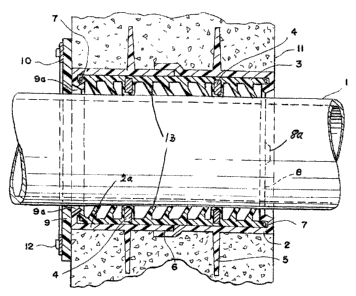Some of the information on this Web page has been provided by external sources. The Government of Canada is not responsible for the accuracy, reliability or currency of the information supplied by external sources. Users wishing to rely upon this information should consult directly with the source of the information. Content provided by external sources is not subject to official languages, privacy and accessibility requirements.
Any discrepancies in the text and image of the Claims and Abstract are due to differing posting times. Text of the Claims and Abstract are posted:
| (12) Patent Application: | (11) CA 2574678 |
|---|---|
| (54) English Title: | HYDRO PENETRATION PREVENTION SLEEVE |
| (54) French Title: | MANCHON POUR PREVENIR LA PENETRATION D'EAU |
| Status: | Dead |
| (51) International Patent Classification (IPC): |
|
|---|---|
| (72) Inventors : |
|
| (73) Owners : |
|
| (71) Applicants : |
|
| (74) Agent: | NA |
| (74) Associate agent: | NA |
| (45) Issued: | |
| (22) Filed Date: | 2007-01-22 |
| (41) Open to Public Inspection: | 2008-04-17 |
| Availability of licence: | N/A |
| (25) Language of filing: | English |
| Patent Cooperation Treaty (PCT): | No |
|---|
| (30) Application Priority Data: | ||||||
|---|---|---|---|---|---|---|
|
A hydro penetration prevention sleeve is used
when building a basement wall wherein said basement wall is
subject to leakage from ground water especially pipes that
have to be placed through the wall. The pipe, mostly a
sewage pipe, has to be placed into the wall at a height
which is just above the sewage pipe located outside the
building or house so that gravity can carry the sewage
toward the outside pipe. A main sleeve is placed into a
concrete casing that will form the wall just prior to
casting the concrete into the casting. The sleeve consists
of PVC and is made of two halves that interfit with each
other and are glued together to accommodate any preset
dimension that matches the preset dimension of the concrete
forms prior to casting. The main sleeve has an interior
hard rubber sleeve that has rings extending to an interior
of the sleeve and the rings are slanted in the direction of
the insertion of the pipe to be inserted therein. When the
pipe is inserted therein, the slanted rings are compressed
by the pipe. The pipe cannot be moved into the opposite
direction because of the compression and friction of the
rings. There are other elements used in sealing the ends
of the main sleeve. One embodiment can be used to seal
pipes against concrete in existing installations.
Note: Claims are shown in the official language in which they were submitted.
Note: Descriptions are shown in the official language in which they were submitted.

For a clearer understanding of the status of the application/patent presented on this page, the site Disclaimer , as well as the definitions for Patent , Administrative Status , Maintenance Fee and Payment History should be consulted.
| Title | Date |
|---|---|
| Forecasted Issue Date | Unavailable |
| (22) Filed | 2007-01-22 |
| (41) Open to Public Inspection | 2008-04-17 |
| Dead Application | 2011-01-24 |
| Abandonment Date | Reason | Reinstatement Date |
|---|---|---|
| 2010-01-22 | FAILURE TO PAY APPLICATION MAINTENANCE FEE |
| Fee Type | Anniversary Year | Due Date | Amount Paid | Paid Date |
|---|---|---|---|---|
| Application Fee | $200.00 | 2007-01-22 | ||
| Maintenance Fee - Application - New Act | 2 | 2009-01-22 | $50.00 | 2009-01-22 |
Note: Records showing the ownership history in alphabetical order.
| Current Owners on Record |
|---|
| STASKAL, JEFFERY GENE |
| Past Owners on Record |
|---|
| None |